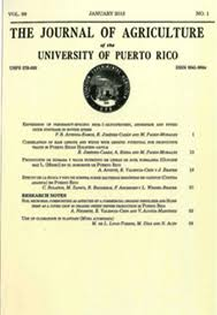Abstract
Although immature fruit of the domesticated species of Cucurbita (pumpkin and squash) are edible, it is usually fruit of C. pepo L. that are harvested as summer (immature) squash. Cucurbita pepo is not widely cultivated in Puerto Rico because of its susceptibility to a variety of diseases. By contrast, C. moschata Duchesne (tropical pumpkin) is well adapted and widely grown on the island but is used almost exclusively as a winter squash, harvested at maturity. We conducted physicochemical, nutritional, and sensory analyses of fresh and stored immature fruits of recently developed tropical pumpkin lines with a novel yellow color to determine their potential use as miniature (“baby”) summer squash. Two-d-old fruits were stored at 5º C for 14 d or at 10º C for 16 d. The nutritional composition of fresh 2-d-old fruits was like that of C. pepo summer squash. Changes in O2 and CO2 composition within sealed bags, and physical and chemical characteristics were measured before and after storage. The effect of fruit age (1- to 5-d-old fruit) on weight and color was evaluated. A sensory panel evaluated the general appearance and flavor of immature tropical pumpkin fruits. Over the storage period, O2 decreased, and CO2 increased within sealed bags. The increase in CO2 was greater at 10º C. Weight loss during storage ranged from 2.22% to 3.11%. There were decreases in luminosity and hue angle, but not chroma; fruits became more difficult to penetrate after storage. Fruits exhibited a decrease in pH, acidity, vitamin C, beta-carotene and antioxidant activity, and an increase in soluble solids and phenolics during storage. The effect of storage temperature on chemical characteristics was significant only for acidity, beta-carotene, and antioxidant activity; there were minimal changes in fruits stored at 10º C. Among 1- to 5-d-old fruit, older fruits tended to have a lower luminosity, with a somewhat more saturated orange color (increased chroma and decreased hue angle), compared to younger fruits. Panelists’ reaction to the appearance of whole, uncooked fruit ranged from “slightly like” to “extremely like”. The evaluation of the flavor of cooked pieces of fruit ranged from “moderately dislike” to “extremely like”, with 82% of participants rating cooked fruit as “slightly like” or better. Tropical pumpkin in its immature state is a fruit with nutritional value, an attractive appearance and a flavor likely to be accepted by consumers. Two-day-old fruit stored at 10° C maintained better quality than did fruit stored at 5° C. The immature fruit of these uniquely colored tropical pumpkin lines are a potentially high-value product for Puerto Rico or other areas where C. pepo cannot be grown.

